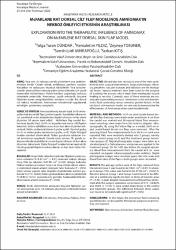| dc.contributor.author | Dündar, Tolga Turan | |
| dc.contributor.author | Yıldız, Kemalettin | |
| dc.contributor.author | Tosuner, Zeynep | |
| dc.contributor.author | Mihrapoğlu, Semih Lütfi | |
| dc.contributor.author | Kitiş, Serkan | |
| dc.date.accessioned | 2021-05-05T22:17:30Z | |
| dc.date.available | 2021-05-05T22:17:30Z | |
| dc.date.issued | 2020 | |
| dc.identifier.issn | 1302-4612 | |
| dc.identifier.issn | 2149-7869 | |
| dc.identifier.uri | https://app.trdizin.gov.tr/makale/TXpneU1EYzFOUT09 | |
| dc.identifier.uri | https://hdl.handle.net/20.500.12933/794 | |
| dc.description.abstract | AMAÇ: Yara yeri cilt nekrozu cerrahi girişimlerin ana problemlerinden biridir. Cerrahi teknik, enfeksiyon, periferik vasküler hastalıklar ve radyasyon etyolojik faktörlerdir. Yara iyileşmesindeki yetersizlikten nekroza giden süreci önlemek için çeşitli materyaller kullanılmıştır. Halen bunların çoğunluğu nekrozu önlemede yetersizdir. Amniomax, çeşitli amniyotik büyüme faktörleri içeren zenginleştirilmiş amniyon sıvısıdır. Rat dorsal cilt nekroz modelinde, Amniomax‘ı intradermal uygulayarak etkinliğini göstermeyi amaçladık. GEREÇ VE YÖNTEM: Anestezi altında, kaudal bazlı 3x10 cm boyutlarında dorsal cilt flep çizimleri yapıldı. Kaudalden itibaren 6. cm işaretlendi ve bu düzeylerden dopler ultrason ile kan akımı ölçümleri 30 saniye kayıt edildi. McFarlane flep modeli kullanılarak kaudal bazlı 3x10 cm boyutlarında dorsal cilt flepleri kaldırıldı. Sütüre edildikten sonra 6.cm kan akım ölçümleri tekrarlandı. Ratlar rastlantısal olarak 2 gruba ayrıldı. Kontrol grubu (n=5) ve tedavi grubu (amniomax grubu, n=5). Dijital fotoğraf imajları standart olarak alındı. Tedavi gurubuna subkutan olarak amniomax uygulandı. Cerrahi işlem sonrası 10. günde sedasyon altında kaudalden 6.cm de dopler ultrason ile kan akım ölçümleri tekrarlandı. Dijital fotoğraf imajları tekrar kayıt edildi. Her iki gruptaki fleplerin nekroz alanları ve kan akım hızları hesaplandı. BULGULAR: Grup I’deki ratlardan kaldırılan fleplerin yüzey alanının ortalama %18.67 cm2 (± 4.01) oranında nekroz olduğu, Grup II’de bu rakamın %47.94 cm2 (±5.03) olduğu bulundu. Nekroz alanları açısından Grup I ve Grup II’deki nekroz alanları istatistiksel olarak anlamlı düzeyde farklı bulundu (P < 0.05). İşlem sonrası yapılan lazer doppler ölçümlerinde, kontrol grubunda % 4.75 ( ±6.82), tedavi grubunda kan akım ölçümlerinde % 59.84 (± 16.55) oranında artış görüldü. Aralarındaki fark istatiksel olarak anlamlı bulundu (P < 0.05). SONUÇ: İleriki dönemlerde amniyotik büyüme faktörleri içeren amniyomax sıvısı cilt nekrozu oluşmasını önlemede tedavi amaçlı kullanılabilir. | en_US |
| dc.description.abstract | OBJECTIVE: Wound site skin necrosis is one of the main problems faced in surgical interventions. Surgical technique, infection, peripheric vascular diseases and radiation are the etiological factors. Various materials have been used for the purpose of avoiding the process which leads from inadequate wound healing to necrosis. Currently, most of these materials are inadequate in preventing necrosis. Amniomax is the enriched amniotic fluid containing various amniotic growth factors. In the rat dorsal skin necrosis model, our aim was to demonstrate the effectiveness of Amniomax when used intradermally. MATERIAL AND METHODS: 3x10 cm-sized caudal-based dorsal skin flap drawings were made under anesthesia. 6 cm from the caudal was marked and 30-second blood flow measurement recordings were made from this level via doppler ultrasonography. By using McFarlane flap as a model, 3x10 cm-sized caudal-based dorsal skin flaps were removed. After the suturing, blood flow measurements from the 6 cm mark were repeated. Rats were randomly divided into 2 groups; namely as the control group (n=5) and the treatment group (amniomax group,n=5). Digital photography images were taken as a standard practice. Subcutaneous amniomax was applied to the treatment group. On the 10th day before the surgical operation, blood flow measurements from the caudal at 6 cm were repeated via doppler ultrasonography under sedation. Digital photography images were recorded again. Necrotic areas and blood flow rates of the flaps in both groups were calculated. RESULTS:The average surface area of the flaps removed from the rats in Group 1 was found to be 18.67 cm2 (±4.01) % whereas in Group 2 this value was found to be 47.94 cm2 ( ±5.03) %. Necrotic areas in Group 1 and Group 2 were found to be different at a statistically significant level in terms of necrotic areas (P < 0.05). In laser doppler measurements of blood flow performed after the surgical operation, an increase of 4.75 ( ±6.82)% and 59.84 (± 16.55) % were noted respectively in the control and treatment groups. The difference between these values was found to be statistically significant (P < 0.05). CONCLUSIONS: In the future, the amniomax fluid containing growth factors can be used for therapeutic purposes in preventing skin necrosis. | en_US |
| dc.language.iso | tur | en_US |
| dc.rights | info:eu-repo/semantics/openAccess | en_US |
| dc.subject | [No Keywords] | en_US |
| dc.title | McFARLANE RAT DORSAL CİLT FLEP MODELİNDE AMNİOMAX’IN NEKROZ ÖNLEYİCİ ETKİSİNİN ARAŞTIRILMASI | en_US |
| dc.title.alternative | EXPLORATION INTO THE THERAPEUTIC INFLUENCE OF AMNIOMAX ON McFARLENE RAT DORSAL SKIN FLAP MODEL | en_US |
| dc.type | article | en_US |
| dc.department | AFSÜ | en_US |
| dc.identifier.volume | 21 | en_US |
| dc.identifier.issue | 3 | en_US |
| dc.identifier.startpage | 244 | en_US |
| dc.identifier.endpage | 250 | en_US |
| dc.relation.journal | Kocatepe Tıp Dergisi | en_US |
| dc.relation.publicationcategory | Makale - Ulusal Hakemli Dergi - Başka Kurum Yazarı | en_US |
















